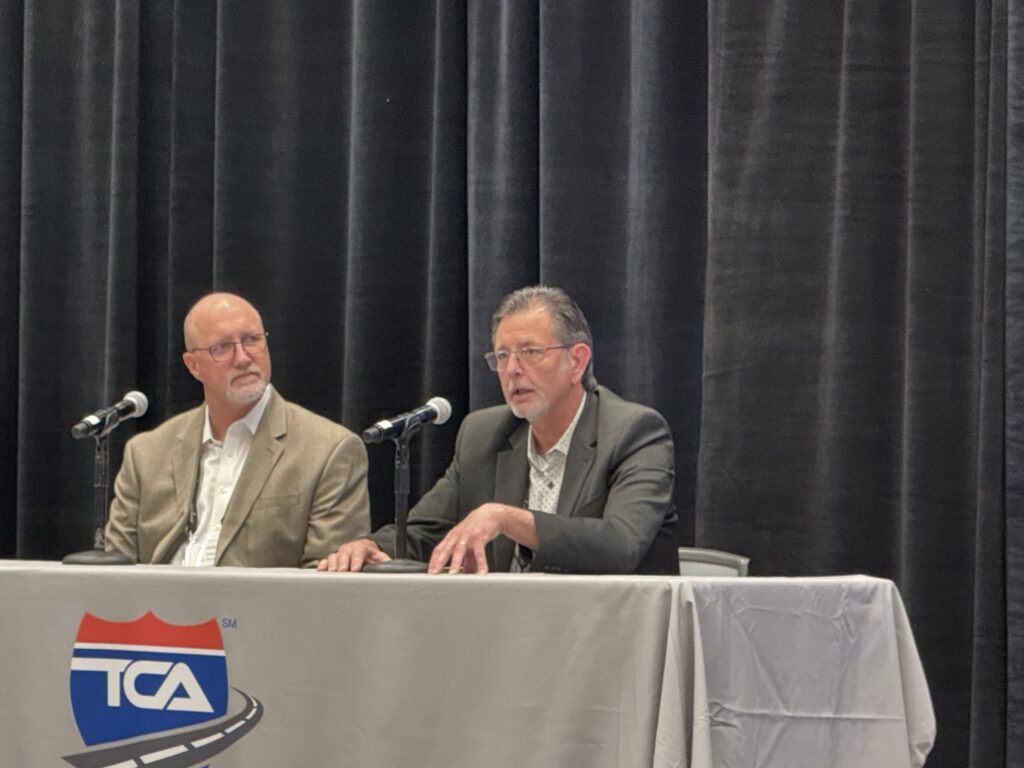Downtime, parts availability, and technician turnover continue to challenge fleet maintenance programs, but carriers are turning to benchmarking, training, and better communication to improve performance across operations.
That was the message from the maintenance analytics panel at the Truckload Carriers Association’s 2025 convention in Phoenix, Ariz., which featured Mike Jeffress, vice-president of maintenance at Maverick Transportation, and Dan Porterfield, senior vice-president of maintenance and equipment control at Covenant Logistics.
Key maintenance metrics
One of the central benchmarks discussed was downtime. Participating fleets reported an average of 1.7 maintenance-related downtime events per truck each month, using 12 hours as the trigger point for tracking. These figures excluded accidents and focused solely on maintenance. Still, downtime varied significantly based on fleet operations and maintenance practices.
Another key figure was miles between unscheduled maintenance events, with the industry average sitting at 22,372 miles(36,004 kilometers).

Tire inventory management was another area of focus. Across fleets, the average was six tire inventory turns per year, meaning tires are replaced approximately every two months.
“We’re a wide base tire user at Maverick, where Dan’s fleet doesn’t use the wide base, so when we got to looking at some of the inventory turnarounds by particular types of tires, we saw that wide base may be turned more frequently than a particular dual tire,” Jeffers added, saying that tire turnover rates depend heavily on application. “For example, our typical wide base, we saw turns close to 12-12.5 times in a particular calendar year where our dual tires were…closer to the average six-term turn.”
Both Porterfield and Jeffress said that while they found these metrics provide a good baseline for truckload fleets, they must be interpreted through the lens of each carrier’s operating profile.
“There is no magic number … [it] depends on what you’re doing with the equipment,” Porterfield said. “If we all operated the same, we wouldn’t have any differentiators.”
This is why no single fleet whose data was used in the report excelled in every maintenance category –each one tends to perform better in some areas than others.
“There’s significant performance variation across fleets, and that’s okay,” Jeffress said. “It’s about understanding what’s driving those differences — and then working on them.”
Proactive planning
Strong maintenance programs are a way of doing that, and they also rely on forward planning and supplier collaboration — not just responding to breakdowns. “You have to be working ahead on maintenance. You have to be thinking ahead on your equipment,” Porterfield said.
He also emphasized the value of daily, weekly, and monthly KPI reviews to ensure equipment is being used effectively.
Jeffress, meanwhile, used brakes and tires as examples of evolving maintenance categories that require close relationships with suppliers. “Involvement of your suppliers and making sure you’re meeting with them on a regular basis, I think, is key number one item, whether you’re developing new technology or just managing the existing stuff that’s been out on the market for years.”
Addressing technician turnover
One of the standout findings from the benchmarking report involved technician retention. Jeffers shared that Maverick reduced its technician turnover rate by implementing targeted training and development of programs based on what their technicians want in their career — a challenge both panelists said requires long-term commitment.
“We reviewed our training program and came up with a totally different model where as a technician progressed through online training sessions and stuff, they got automatic pay raises. We saw a significant reduction in our turnover from roughly 40-something [percent] down to the high 20s,” Jeffers said. He added that Maverick technicians must recertify every two years, and the company invests heavily in technician development to keep up with advancing vehicle technologies.
Porterfield agreed, adding that compensation alone won’t solve retention issues. “Money sometimes gets you in the door, but money doesn’t retain anybody. I think you’ve got to show a career path. You have to give them some picture of, ‘How can I improve myself and put me and my family in a better position.’”